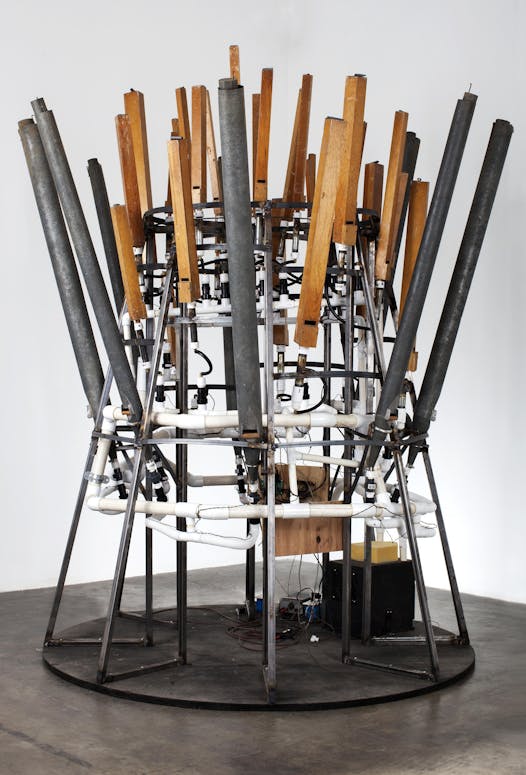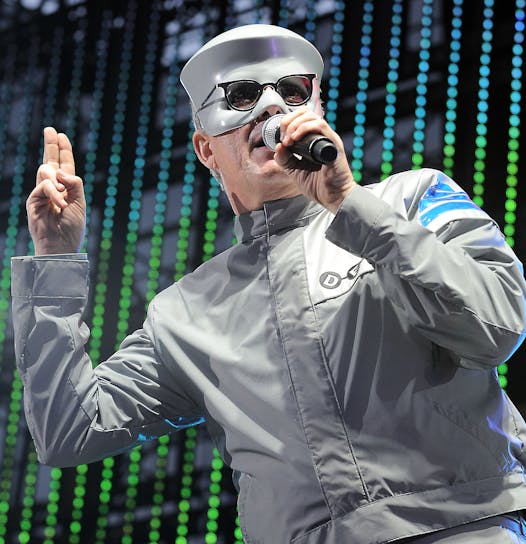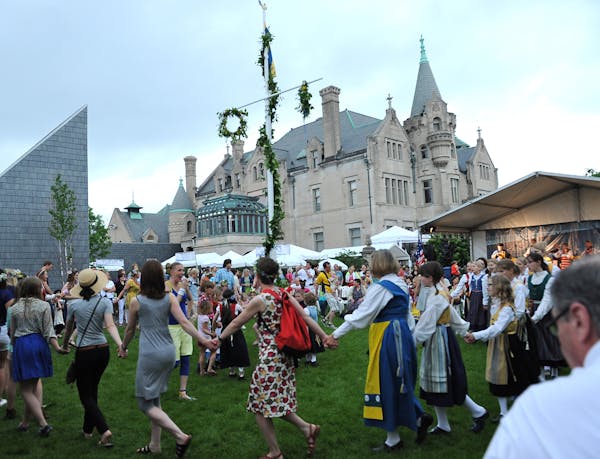Mark Mothersbaugh is doodling. He is always doodling.
It's why he has put me on speakerphone: to keep his hands free for the perseverative sketching that has kept his fingers itching for the past six decades, something he calls a "discipline and an obsession and a compulsion." He draws every day, no matter what. And if he doesn't, he says, he feels "cold and clammy and nervous about it." He sometimes awakes in the middle of the night fiending for a sketchpad.
You know Mothersbaugh. He's the guy from Devo, beloved New Wave band, best remembered for stackable red hats, campy dystopia and rousing admonitions to "whip it." Since then, Mothersbaugh has surfed a comfortable career as a Hollywood composer, writing music for TV and film — credits include "Rugrats" and "Beekman's World," as well as the scores for half of director Wes Anderson's films. And now at 65, he finds himself branching into a new realm: the fine art world.
This weekend "Mark Mothersbaugh: Myopia," organized this year by the Museum of Contemporary Art Denver, travels to the Minneapolis Institute of Arts. Billed as a retrospective, the exhibition is the first comprehensive presentation of Mothersbaugh's visual output — which precedes, overwhelms and informs all things Devo. It is a petri dish of oddball arcana, sprouting all kinds of exotic flora. Fuzzy, illustrated rugs hang alongside manipulated photography. Fantastical musical instruments made of birdcalls share billing with a giant ruby carved into a custard cone.
And then, of course, there are those daily drawings. The show contains more than 30,000 of them, each postcard-sized and searingly colored.
Mothersbaugh, calling from his L.A. recording studio (a former surgical theater in a plastic surgeon's office), tells how it all started.
As a kid in Akron, Ohio, he was legally blind. He spent years stumbling through a world of amorphous, colored fog — and failing, humiliatingly, his way through first grade.
"I spent every day being spanked, sent to the office and standing in a corner," he said.
Then, just before his eighth birthday, he got glasses. It was a biblical, scales-falling-from-the-eyes event. "I'd never seen a tree before," he remembers. "I saw the tops of houses, I saw clouds, birds, what a sidewalk looked like — all in one moment. It was the most amazing moment of my life."
Drunk on this visual awakening, he began documenting, feverishly, the ecstatic, mind-melting newness. And because without his glasses he couldn't see beyond 5 inches from his face, he concentrated his efforts into miniature 5- by 7-inch vistas. To this day, Motherbaugh's postcards — his most notable body of work — crackle with synaptic short-circuiting. They are an epic storyboard of over- sensory awe.
But the small scale of the drawings had another benefit: They were the perfect size for the Postal Art movement, a late Fluxus-era practice, peaking in the 1950s and '60s, of exchanging works through the mail. By the late '60s, Mothersbaugh was mailing drawings all over North America — and occasionally receiving micro-works back from budding luminaries such as Jasper Johns and Robert Indiana.
He had also enrolled as a fine arts major at Kent State, just in time to witness the infamous shooting, on May 4, 1970, of students by the Ohio National Guard.
In the aftermath of the violence, while the school was shut down, Jerry Casale, a friend and art collaborator, would drop by Mothersbaugh's place for deep discussions of what the two saw as an emergent, nightmarish moment of history. "What we were seeing wasn't humanity's evolution," Mothersbaugh said. "It was de-evolution." The art gang Devo was born. Mothersbaugh and Casale, along with fellow student (and now Minneapolis-based video editor) Chuck Statler, began making barbed, absurdist videos. The band Devo grew out of these early projects.
Today, said Chris Atkins, MIA curator in charge of the show, that cultural critique looms large in the retrospective. He points to "Four Dead in Ohio" — a fastidious ink drawing of a group of infant-like characters, four of whom have blood spilling from their mouths and torsos. The show also includes an ad for Honda scooters, featuring the Devo band members posing in identical uniforms, along with the slogan "Express your individuality."
This kind of needling, nostalgic rebellion is the defining mood. For better or worse, the retrospective feels like a gleeful hopscotch through the obvious enfants terrible of art history. References abound to Dada pranksterism, Futurist mechanical fetish, Pop Art cheek. A 4-foot-tall sculpture of two My Little Pony butts mashed together bears the high-gloss/low-taste extravagance of Jeff Koons.
In this way, it's nice having the works in an encyclopedic institution such as the MIA. After seeing the show, visitors can seek out antecedents in the permanent collection. "Orchestrions," for example — giant, mechanical instruments made from birdcalls — are natural progeny of Nick Cave's sound suits.
But the centerpiece is the postcards. Atkins calls them "the primordial soup that most of the other works emerged from." Arranged on low tables in a central gallery, they anchor "the most dramatic room in the show."
Speaking of which, Mothersbaugh tells me he has wrapped up the doodle. It's a "handsome malcontent," he said, a figure who is staring up a ladder that leads to a sewer lid in the sky. "He's either about to climb up into the sky-sewer, or he's waiting for something to come down."
Either way, it's ominous — and like all things Devo, an excavation of the sludge flowing beneath all things earthly. Best to get it out from underground and put it in the sky. So we can all look at it.
Gregory J. Scott is a Minneapolis arts writer.

Gophers football coach P.J. Fleck lists 'resort-style' Edina home for $3.9 million
Mexican film wins top prize at Moscow International Film Festival while major studios boycott Russia
Why you might have heard Paul Simon's 'The Sound of Silence' at Spanish Mass

Minneapolis native Poppy Harlow parts ways with CNN





